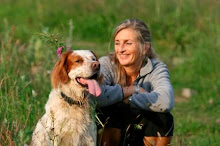 The Association of Pet Dog Trainers is dedicated to enhancing the human-dog relationship through the education of both dogs and owners. Training your dog will be so much easier if you develop a ‘right relationship’ explains Karin Bridge, President of A.P.D.T.
The Association of Pet Dog Trainers is dedicated to enhancing the human-dog relationship through the education of both dogs and owners. Training your dog will be so much easier if you develop a ‘right relationship’ explains Karin Bridge, President of A.P.D.T.
If you really want your dog to co-operate with you and do as you ask you need to teach it not only what you want but also provide a reason why?
You might think of training as simply teaching your dog what words or signals mean - connecting a behaviour such as ‘sitting’ with a signal to sit. This should provide understanding to the dog of what we want.
However dogs are not robots, they will not necessarily do as you ask just because they understand what it means. You must also provide motivation for performing the behaviour – the why?
A classic example was my dog Jack who competed in the highest levels of obedience competitions, yet if my son’s friends asked him to ‘sit’ – he’d just stand and stare as if to say “your nobody special... why should I do it for you ?” This is a large part of ‘who dogs are’. Food, toys and praise are tools you can use to help provide motivation and encourage your dog to repeat the behaviours you want such as ‘sit’ and ‘come’. Ultimately however it is establishing a ‘right relationship’ with your dog that will ensure he will reliably comply with your requests.
Developing a ‘right’ relationship with your dog.
The first step is to earn your dog’s trust and confidence. This is done by providing him with all the things he needs to have a good life, not only the basics such as food, water, shelter and health care but also:
- Companionship
- Opportunities to meet and greet people
- Opportunities to meet and play with other dogs
- Regular exercise
- A safe environment both in and out of the home. Many dogs feel frightened in new environments. It’s your job to make sure your dog is enjoying play at the dog park or a hug from a young child. Supervise and intervene if necessary so your dog does not have to
- An education. Dogs need to learn human etiquette in a positive and nurturing way. Humans expect dogs not to pee in the house, not to pull on a lead, not to jump on visitors, not to dig holes even when bored, not to chase the neighbour’s cat, not to bark at invited guests but to bark at strangers at the door – and lots of other confusing stuff! Your dog isn’t born with this knowledge – he needs YOU to teach it to him
The second step is to teach your dog that all good things come from YOU! You may already be providing good things to your dog but does he know that? Rewards need to be provided as soon as your dog does what you want - ‘this’ for ‘that’. To help you remember, make a list of all the things your dog wants and a list of all the things you want. For example:
| DOG DESIRES – ‘THIS’ | YOU DESIRE – ‘THAT’ |
| Food x 100 (mostly a proportion of the dog’s dinner NOT lots of special ‘treats’) | Sit x 100 (the doggy equivalent of saying ‘please’) |
| Go for walk (lead on) | Attention |
| Your attention | Come |
| Play tug | Settle |
| Run free (lead off) | Down |
| Chase ball | Fetch |
| Come inside | Quiet |
| Walk toward park | Walk nicely |
| Cuddle on couch | Shake hands |
Now, it’s a simple matter of continually swapping something your dogs wants - ‘this’ for something you want - ‘that’. Assuming your dog understands what you want - distributing rewards ‘this’ for ‘that’ should ensure he also learns why he should do it for you.
Thanks to Karin Bridge, President A.P.D.T. for contributing this article.
Please come back for PART II of this article - coming soon....







No comments:
Post a Comment